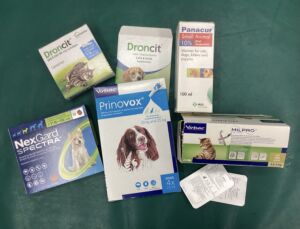Worming your pet can seem like a daunting task, there is a remarkable variety in the treatments that are available and each option has its pros and cons. Some protect against this but not that, some only cover one particular worm and some should not even be used for certain pets! It’s a lot of information to process so we want to help you better understand so that choosing the correct wormer for your pet is not so scary.
Types of worm
In the UK, the common worms we treat against include:
- Roundworms (hookworms, heartworms, lungworms, eye worms)
- Tapeworms
Each have their own individual lifecycle, and you will find that the treatments that cover these worms will aim to also protect against these parasites during their different life stages.
Most of their names are self explanatory i.e. lungworms tend to reside within the lungs of cats and dogs. Some of them are named due to their anatomy i.e. hookworms have hook-like teeth that they use to latch onto the small intestine of their host. Tapeworms are named so due to their tape-like appearance.
Worm lifecycle
Life cycles can vary between worm species, in general worms will invade an intermediate host (e.g. foxes, livestock, fleas) before reaching their definitive host (cats, dogs, and humans!).
1- Adults will release eggs into the environment, usually via faeces from their host, and the eggs will develop into larva.
2-The intermediate host will then ingest these larva or eggs, where they then grow more as they feed off of this host.
3-The intermediate host then passes on these larva, usually by predation from the definitive host (e.g. a rat eaten by a cat) and infect this new host. In the case of tapeworms, dogs and cats will become infected through ingestion of fleas carrying tapeworm eggs during their regular grooming patterns.
Problems arising from worms
A worm burden, when significant, can become a serious health risk. Large amounts of worms residing in the gut can cause an impaction. In the case of lungworm, where the burden will reside in the lungs, this can affect breathing.
Signs that your pet may have worms include:
- Eggs seen in the faeces or around their bottom
- Scooting
- Weight loss
- A pot-bellied appearance
- Diarrhoea
- Coughing
- Poor coat condition
- Dehydration
- Lethargy, in some cases, exercise intolerance
Some pets may not show any symptoms, so it’s best to keep them up to date with routine worming treatments.
Worm treatments
Here at Rochford Vets we have a variety of treatment options to suit you and your pet. Some treatments are topical- meaning you apply them to the skin. Others can be given orally in the form of a tablet or tasty chew.
Roundworm treatments should usually be given once every 4 weeks, and are often incorporated into monthly flea treatments. Tapeworm treatments are usually given once every 3 to 6 months, depending on your pet’s lifestyle.
An example of our roundworm topical treatments is Prinovox spot-on which is available for both cats and dogs. Our topical tapeworm treatment is the Droncit spot-on, however this is only available for cats.
For our young puppies and kittens, Panacur is often first choice. This is a paste that you put with their food. This treatment is for roundworms as well as other infectious micro-organisms such as Giardia. Panacur can be given to pregnant dogs as well to avoid puppies being born with a worm burden, or worms being transferred to the litter through the milk.
Weigh and worms
As puppies and kittens grow, their weight needs to be checked monthly for ongoing flea and worming treatments. This ensures that they have the correct dosage of treatment and that it is effective. Our nurses can take your pet’s weight and, given that a vet has confirmed that your pet is fit to receive the prescribed treatment long term, adjust the dosage accordingly as they grow.
Please note: in January 2024 a new regulation will come into place from the RCVS (our regulatory body). This regulation requires pets to have a physical examination from a veterinarian before changing dosage or type of flea and worm treatment.
This does not affect pets that have been checked by a vet within the 12 months prior to this, given that they have had written confirmation on file that they can receive a named treatment/dosage at these checks.



